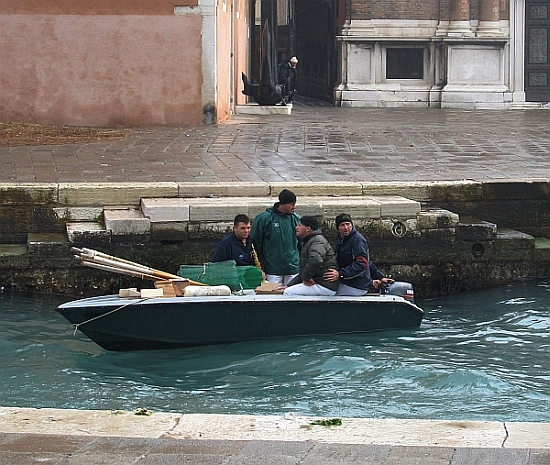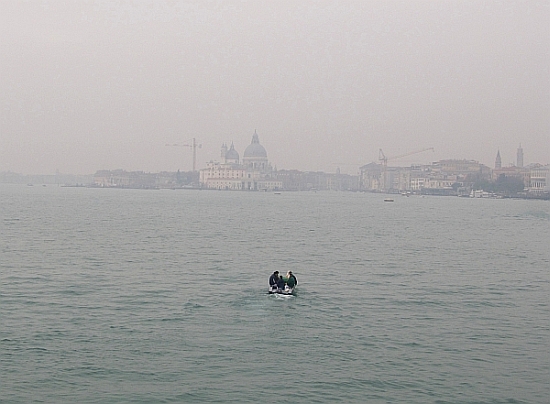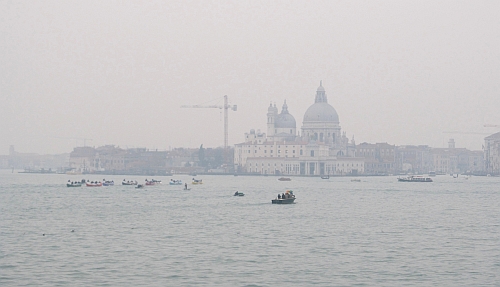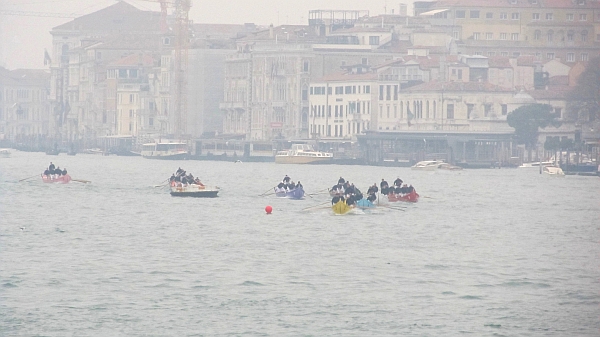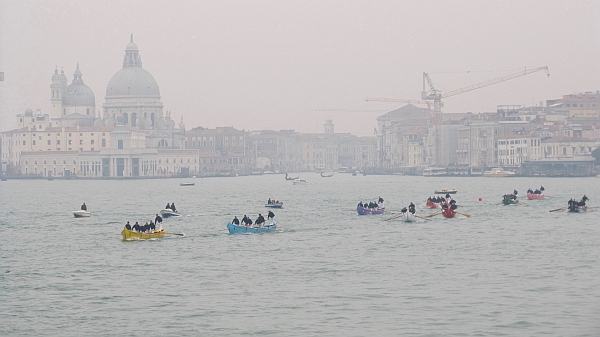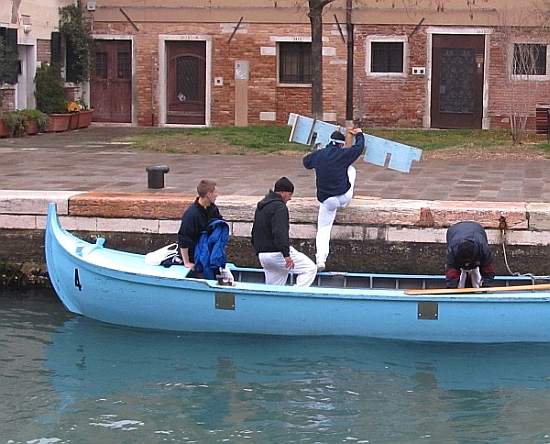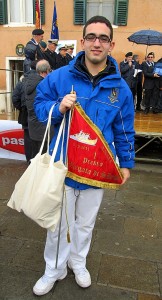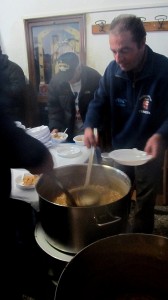Last Saturday I went to watch one of my favorite Venetian rowing races: The regata of Santa Barbara, an annual contest on six-oar caorlinas organized by the discharged sailors’ association in honor of Saint Barbara, patron saint of seamen and, by extension, of the Navy.
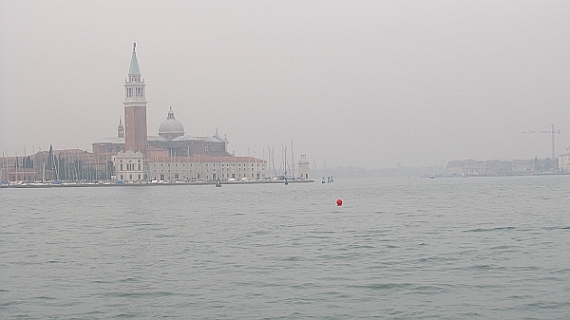
For every Regata Storica, there must be ten races held every month here (I’m making this number up — maybe it’s more), winter or summer, by rowing clubs, gondoliers, and assorted groups of every sort. And don’t think that just because there isn’t any prize money that these races aren’t fought to the finish.
Technically, Saint Barbara’s day is December 4, but Saturday was more convenient for everybody and no doubt the good saint took it in stride. After all, her bones supposedly lay in a cupboard somewhere on Murano for about 400 years, so she’s fully aware of the prevailing attitude toward time here.
The crew of each boat was composed of four gondoliers who had done their (formerly compulsive) military service in the Navy, plus one boy from the Scuola Navale Militare F. Morosini, where Lino teaches rowing. For the first time in 15 years, there was also one fireman.
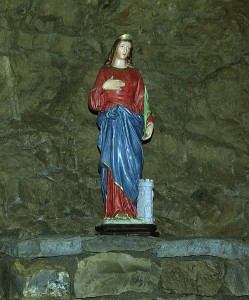
The firemen weren’t there to quell any spontaneous combustion; Saint Barbara is their patron saint too. Generally speaking, she is assigned to watch over anyone who is dealing — intentionally or not — with things that go “boom.” If there are explosives, fire, or lightning involved, or the threat of sudden, violent, incendiary death, she is your go-to saint, and specifically protects sailors, firemen, artillerymen, miners, sappers, road-builders, geologists, mountaineers, petroleum workers, and the U.S. Navy and Marine Corps Aviation ordnancemen. Also bell-ringers and architects — maybe there’s a link to high towers with no lightning rod. This list is not exhaustive, by the way, I just decided to stop.
Trivia alert: A powder-magazine or other storage area containing explosives is often referred to as the “santabarbara.”
It rained and fogged. This is typical. There have been times in the past 15 years when the sun beamed down on victors and vanquished alike but usually there’s water. Perhaps this is a helpful gesture from the saint, who abhors fire.
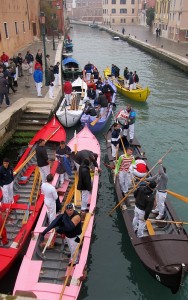
There were all the usual components: Competitors who have known each other since before they were born, the benediction of the boats, the traditional pennants for the first four boats to cross the finish line, and other prizes offered by sponsors (Pasta Zara sent everyone home with a neat box containing two kilos of pasta), bottles of wine, even small trophies of Murano glass, presumably not in memory of Saint Barbara’s sojourn on the island.
There were assorted dignitaries, including an admiral, some of whom gave impromptu speeches into a microphone which could have used a dash of nitroglycerine to wake it up. Nobody listens anyway. The speeches were, also according to tradition, too long, too rambling, and often more than a little bit too self-congratulatory. I will not name names but I know who they were.
The prizes were given, the photos were snapped, then everybody headed for the buffet. As I have often mentioned, “Every psalm ends with the Gloria,” as they say here, and every event ends with food and drink.
And tradition requires — or maybe Saint Barbara requires, she being an extremely practical saint, it seems to me — that there should be pasta e fagioli. Not only at this race, but at 98 percent of amateur races here. Pasta and beans are hot, filling, delicious, hugely good for you and can be made in massive batches reasonably far in advance. Trivia alert: Beans such as the borlotti used around here contain more protein than red meat, though I don’t think anybody cares.
So carry your bottle of Beano and dig in. Or plan to spend the rest of the day outdoors, in the fresh air. For a gondolier, that’s obviously no problem. They often go back for seconds.
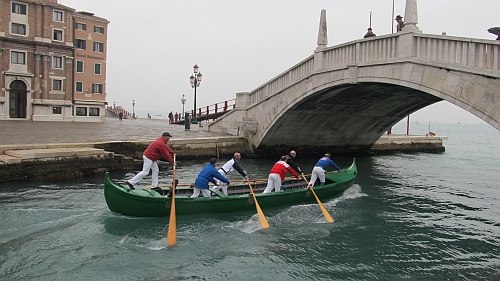
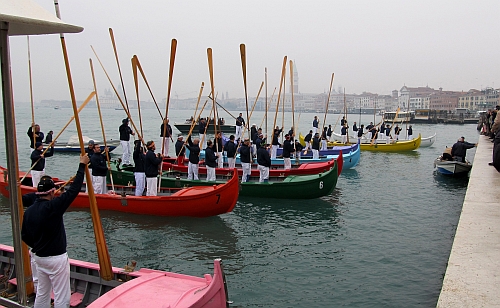
- And they’re off! The starting line was down toward the Lido, even with the Giardini (Biennale) vaporetto stop, and they race to the Bacino of San Marco, go around one of the permanent buoys for ships and race down toward the Arsenal. Not very long, but there’s enough distance for strategy and maneuvering.
- There are people ashore, like Lino, who can distinguish all the boat colors even in the fog. Then there are those like me.
- Rounding the buoy — two of them, actually. On the left is the permanent black-and-grey float, plus an orange one as well, to prevent the rowers to cut cross-lots on the return and possibly run into boats that hadn’t yet rounded the buoy.
- Thundering toward home. We can finally distinguish the outcome: Yellow, blue, white, and red will get the appropriate pennants. The rest are battling it out anyway. Never give up the ship.
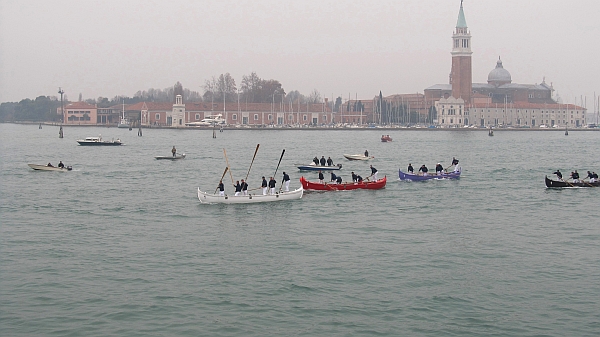
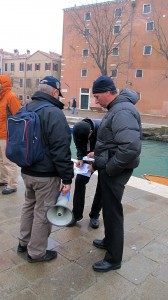
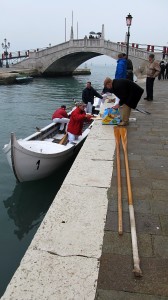
This young man – I’m assuming he practices yoga when he’s not rowing --is removing the platform on which he was standing. Each rower has one, but they belong to the boat. He's probably going to remove the wooden strips he had nailed to its underside. The boats are stripped and all the speeches are finally over . On to the prize-giving, the perfect moment for the rain to start. Third-year cadet Luca Merola displays his first-place red pennant, the perfect gift for today, his 18th birthday. We eat! There’s enough pasta e fagioli to feed three battleships. The plastic bowls are also part of the tradition; weakened by the scalding heat of the contents and the weight of the jumbo portion, they sag dangerously and you burn your hands trying to hold them. It would depress me if this, for some reason, were not to happen.
